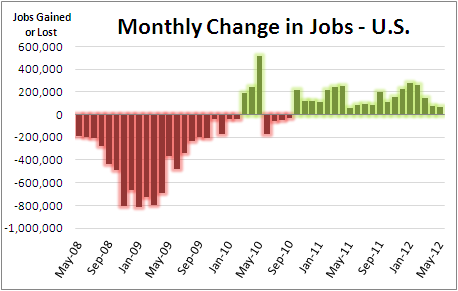The Labor Department’s Bureau of Labor Statistics (BLS) said early Friday that the U.S. economy created just 69,000 non-farm jobs in May, the smallest monthly increase in a year. The official unemployment rate increased to 8.2 percent from 8.1 in April.
Economists had expected better news, with average forecasts of around 150,000 new jobs in the month. BLS noted that the increase in the unemployment rate was at least partially due to increased labor market participation, as more people were lured back into job searches by encouraging labor news in the first quarter of 2012.
But the rest of Friday’s report was dismal. In addition to the weak job growth in May, the number of jobs created in April and March were revised downward by a total of 49,000 in the new report.
An alternative measure of unemployment and underemployment — called the U-6 measure, which factors in marginally attached workers, discouraged workers, and those working part time against their wishes — increased to a seasonally adjust 14.8 percent rate in May from 14.5 percent in April. But the U-6 measure for May 2012 is still a full percentage point better than the 15.8 percent reading in May 2011.
The sector with the most robust job growth in May was healthcare, which added 33,000 workers. Another 36,000 jobs were added in the warehousing and transportation sector and 12,000 manufacturing positions were filled. BLS said that since hitting a low in January 2010, nearly 500,000 manufacturing jobs have been created in the U.S.
Construction was the biggest loser in the month, shedding 28,000 jobs.
 May’s slowed job growth pace bolstered fears that the U.S. economy is significantly slowing down in the second quarter, possibly even headed for another recession. Job growth was much higher in the first quarter of 2012, averaging 226,000 per month. In the first two months of the second quarter, monthly job gains are averaging 73,000.
May’s slowed job growth pace bolstered fears that the U.S. economy is significantly slowing down in the second quarter, possibly even headed for another recession. Job growth was much higher in the first quarter of 2012, averaging 226,000 per month. In the first two months of the second quarter, monthly job gains are averaging 73,000.
Even with the relatively robust growth of the first quarter, job creation in 2011 and 2012 has paled in comparison to the employment bloodbath of mid-2008 through mid-2009.




![[Image by creator from ]](/media/images/patrick-lunsford.2e16d0ba.fill-500x500.jpg)


![[Image by creator from ]](/media/images/Collections_Staffing_Full_Cover_Thumbnail.max-80x80.jpg)
![Report cover reads One Conversation Multiple Channels AI-powered Multichannel Outreach from Skit.ai [Image by creator from ]](/media/images/Skit.ai_Landing_Page__Whitepaper_.max-80x80.png)
![Report cover reads Bad Debt Rising New ebook Finvi [Image by creator from ]](/media/images/Finvi_Bad_Debt_Rising_WP.max-80x80.png)
![Report cover reads Seizing the Opportunity in Uncertain Times: The Third-Party Collections Industry in 2023 by TransUnion, prepared by datos insights [Image by creator from ]](/media/images/TU_Survey_Report_12-23_Cover.max-80x80.png)
![[Image by creator from ]](/media/images/Skit_Banner_.max-80x80.jpg)
![Whitepaper cover reads: Navigating Collections Licensing: How to Reduce Financial, Legal, and Regulatory Exposure w/ Cornerstone company logo [Image by creator from ]](/media/images/Navigating_Collections_Licensing_How_to_Reduce.max-80x80.png)